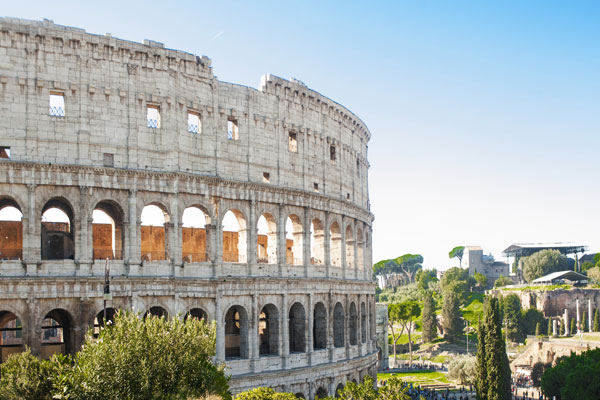Five Fascinating Facts about the Colosseum
One of the most iconic ancient Roman buildings, the Colosseum, is one of the New Seven Wonders of the World. Also known as the Flavian Amphitheater, the historical Colosseum is a monumental architectural feat.
Here are five facts about the Colosseum, which make it one of the most popular destinations in Italy.
1. A Guinness World Record as the Largest Amphitheatre
The Colosseum holds a Guinness World Record as the largest amphitheater. At 189 meters long and 156 meters wide, it has a base area of 24,000 square meters.
The ruins that remain today are about a third of the original construction. Earthquakes, fire, and general neglect resulted in the Colosseum being left in ruin. Over the years, parts of the Colosseum were taken to be used in the construction of other Roman buildings. Saint Peter’s Basilica being one of the other important Roman structures that benefited.
2. The Colosseum is a Unique Freestanding Structure
The Colosseum was built with concrete, sand, travertine limestone, and tuff (volcanic rock). Construction started in 72 A.D. by Emperor Vespasian. His son Emperor Titus completed it in 80 A.D. whilst his brother, Emperor Domitian, completed the last stages and the underground tunnels.
The Colosseum design is unique as many of the earlier amphitheaters had been dug into hillsides for extra support. A freestanding structure, the Colosseum has a distinctive exterior featuring three stories of arched entrances.
3. A Huge Network of Underground Tunnels
There is more to the Colosseum than meets the eye. The wooden floor of the arena covered the hypogeum (Latin for ‘underground’). The series of tunnels, underground passages, and cages held the gladiators and animals before they met their fate in the arena.
Hydraulic elevators and pulleys provided access between the different levels and were used to raise props, scenery, caged animals, and gladiators.
4. A Major Entertainment Venue
The Colosseum was a major entertainment venue. Emperor Titus hosted the inaugural games in 80 A.D. which lasted an impressive one hundred days. Entertainment back then was brutal with gladiator combats, wild animal fights, and other shows hosted during these games.
Seemingly, the amphitheater held between 50,000 to 80,000 spectators. In recent years, some Italian and international artists have performed at the Colosseum or used it as a stunning backdrop. Andrea Bocelli, Ray Charles, Elton John, and Paul McCartney are just a few or the stars who have performed at the Colosseum.
5. Efficient Crowd Control and the Vomitorium
The crowds attending events needed a way to enter and exit the venue quickly. The Roman Emperor accessed the venue via the northern staircase and the elite through three other entrances. Ordinary spectators accessed the Colosseum through the remaining seventy-six arched entrances.
As to be expected, the Emperor and the elites of ancient Roman society had the seats with the best views of the action. Seat allocation inside the amphitheater was based on social status. Ordinary people accessed their seats through the vomitoria, a series of passages that led out to tiers of seats.
Today the Colosseum is one of the most popular tourist attractions in Italy. Would you like to experience the atmosphere of the Colosseum and see if through the eyes of a gladiator? We have a selection of tours and experienced tour guides who would be delighted to share their knowledge of the history of the Colosseum with visitors. For all our Colosseum tours check out best Colosseum Tours

